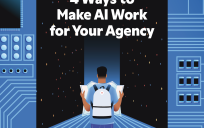By Mav Turner, VP Product Strategy, SolarWinds
Technology for federal agencies is becoming more and more complex at what feels like the speed of light. More devices are connecting to agency infrastructure and at the same time, those devices and systems are all generating and collecting more data. Legacy approaches for dealing with these systems and data don’t work at this scale, so new approaches and technology are needed.
As the infrastructure and technologies advance, so must federal IT departments in terms of specialties, roles, tasks, and more.
This evolution can feel scary—and some federal IT pros may even fear AI and similar technologies will threaten job security. The reality is that these advanced technologies can actually provide much-needed assistance to teams looking to manage new complexities in IT.
What is machine learning (ML)?
Let’s step back for a moment to understand what machine learning is versus AI, and how both will uniquely impact the federal IT environment.
From a high-level perspective, machine learning is a branch of artificial intelligence (AI) that focuses on creating and improving algorithms that can help quickly identify patterns in large sets of data. This is particularly valuable in IT given the growing complexity and amount of data being generated. These models can be created in a lab on test data and then deployed into the field or can be trained in live environments where they improve and tune over time. Machine learning is primarily about identification as opposed to action. One way to think about the greater field of AI is how a system will leverage multiple models from different domains with the ability to decide and act autonomously. That complex, situational decision making based on different types of data is what elevates the discussion to intelligence, or AI.
There is also an important distinction between general and narrow AI. Most science fiction and fear-mongering talk is about general AI. The reality is ML and narrow AI are both great ways to augment IT professionals’ day-to-day tasks in a way that will allow them to be more efficient and effective. A simple, historical comparison is how we now use spreadsheets and calculators as tools to be more effective and knowledgeable workers. The practical, daily benefit of ML is that it enables us to identify the root cause faster and minimize downtime.
If a system is using pre-defined patterns, signatures, or rules, it’s not really providing intelligence. As systems are able to experience new information, make decisions, and take action, we can see the potential for AI.
Imagine the value of this to the federal IT team, particularly given the growing complexity of the agency infrastructure, skills gap, and ever-increasing rate of change in IT. In a real-world example, AI will be able to allow computers to automatically recognize a cybersecurity threat to an agency’s infrastructure, automatically respond, and automatically thwart the attack without the manual intervention of the IT or security team.
In other words, machine-based technologies may well be the federal IT pro’s best toolset in helping successfully manage increasing complexity with security matters while helping to optimize performance and operations.
Preparing for machine learning
How should an agency prepare for this type of technology?
From a personnel perspective, one of the best ways to prepare is to ensure federal IT teams are educated about the reality of these technologies. For example, two of the most commonly lacking skillsets on many IT teams are data scientists and machine learning specialists. However, without improvement in time and budget constraints, the majority of tech pros say they will be unable to confidently manage future innovations. This reality ultimately puts government agencies at risk of performance losses, making the prioritization of skills and career development for tech pros paramount.
From a technology perspective, it’s important to be sure agency data is ready for the shift. Let’s remember that machine learning technologies learn from existing data. Most agencies have data centers full of information—some are labeled and clean, but most are not, meaning errors live among the correct information. The best way to prepare is to clean up the agency’s data store, as bad data will lead to bad automatic decisions.
Finally, there is also a management perspective.
The federal IT pro of the very near future will be tasked with finding ways to use new technologies to enhance efficiency, modernize processes, and drive further digital transformation. Tomorrow’s federal IT pro will be in a much more strategic position, advising higher-level leadership on precisely what new products and technologies the agency should invest in, what enhanced responsibilities the IT team should take on, and how the agency should move forward, technologically speaking.
So, the takeaway is this: learn about and embrace AI and machine learning technologies. They will more than likely provide much-needed relief and the opportunity for innovation for an overworked federal IT team.





Leave a Reply
You must be logged in to post a comment.